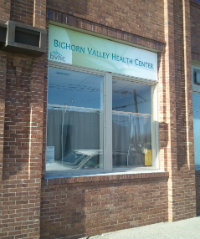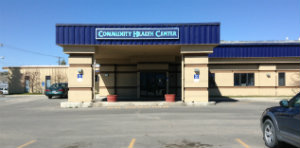 The stark beauty of the landscape near Hardin, Mont.
The stark beauty of the landscape near Hardin, Mont.National Mental Health Month, which comes in May each year, has meant more to me since launching our initiative to spread the IMPACT model of depression treatment in the five-state WWAMI region (Washington, Wyoming, Alaska, Montana, and Idaho) under the federal banner of the Social Innovation Fund (SIF).
Today, we are celebrating the selection of our second batch of SIF subgrantees. We are proud to announce awards to the following organizations:
- Bighorn Valley Health Center in Hardin, Mont., is a Federally Qualified Health Center (FQHC) located in southeastern Montana. It serves a diverse population of 13,000 spread over an area of nearly 5,000 square miles, encompassing most of the Crow Indian Reservation and part of the Northern Cheyenne Indian Reservation. Award amount: $230,000 over two years.
- Butte Community Health Center in Butte, Mont., also a Federally Qualified Health Center, has provided primary care services to southwest Montana for more than 28 years. It serves nearly one-third of the population of southwest Montana, with more than 17,000 patients cared for annually. Award amount: $200,000 over two years.
- Kodiak Area Native Association (KANA) in Kodiak, Alaska, was formed in 1966 as a 501(c)(3) nonprofit corporation to provide health and social services for Alaska Natives in the City of Kodiak and six remote Alaska Native villages (Akhiok, Karluk, Larsen Bay, Old Harbor, Ouzinkie and Port Lions), serving 10 federally recognized Tribes of Kodiak Island. Award amount: $384,000 over two years.
 The Bighorn Valley Health Center in Hardin, Mont., serves an area covering nearly 5,000 square miles.
The Bighorn Valley Health Center in Hardin, Mont., serves an area covering nearly 5,000 square miles.I’ll be reporting on their story in subsequent blog entries. But here I also want to look back at the progress we’ve made with our first cohort of grantees.
The experience of working with clinics to implement the model has given me a window on the current state of mental health resources in the region and the forces that come together to support those suffering from depression in communities far and wide. In sum, it really does take a village—and then some.
As I mentioned in a previous post, the sources of stress and the disadvantages that these communities confront are clear. Wherever you look, there’s evidence of economic hardship, unemployment, substance abuse, and the absence of vibrant social support systems—all of which conspire against vulnerable low-income populations.
The success of our work thus far would not have been possible without the extraordinary commitment, dedication, and stick-to-itiveness of clinicians on the frontlines as well as the network and support of partners across local, state, and national lines—all under the umbrella of the SIF. Among them is a diverse array of funding partners: the Kinskey Family Foundation in Wyoming; the public health department and the Board of County Commissioners in Lewis County, Washington; the Rasmuson Foundation; and the Margaret A. Cargill Foundation.
 Butte Community Health Center serves nearly one-third the population of southwest Montana.
Butte Community Health Center serves nearly one-third the population of southwest Montana.To date, we’ve served more than 600 people since the sites launched their clinical programs seven months ago. In that short amount of time, we’ve seen tremendous progress in response to treatment.
It’s particularly heartwarming to hear from patients and providers about how we are making a difference in these communities. A letter from one patient describes how the IMPACT model has helped to transform the patient’s life by helping that person “beat any symptoms that may lead to depression.”
Another story, this one from a care manager, illustrates the power of collaborative care to overcome the serious social and economic barriers to good health in vulnerable communities:
John [not his real name], a man in his late 40s with Type 2 diabetes, COPD, Atrial Fibrillation, Sleep Apnea Obstructive, Morbid Obesity, Asthma, Hemochromatosis, major depression, and anxiety, started treatment experiencing an incredible amount of negativity, paralysis and hopelessness. He’s not been able to work for several years due to his depression and medical conditions. He has a BMI of 56 percent, weighing over 400 pounds at 5’10”, and he is socially isolated. His transportation is limited to getting rides from friends and family and he has an active eating disorder. After nine weeks in treatment, a change in his psychiatric medication, and a coordinated effort for behavioral activation and psychotherapy, he has reported a 12 point decrease in his PHQ-9, a 6 point decrease in his GAD-7 [Editor's Note: PHQ-9 and GAD-7 are questionnaires for diagnosing depression.] and successes that include but are not limited to walking 1.35 miles five days a week, and socializing or engaging in self-help or support activities on a daily basis. He has also laughed and spoken about his future in a positive way during his last several conversations [with his care manager].
Yet another care manager relates how we’ve helped a patient restore her sense of well-being and assisted her on the path back to full-time employment:
Sara presented with an initial PHQ-9 score of 24. She is diabetic and was having difficulty complying with her primary care treatment plan. She was diagnosed with depression and prescribed medication. After 20 weeks of treatment, her PHQ score is now 4. She has gotten a job, is exercising, checking her blood sugar regularly, and successfully managing her diabetes and generally making things better for herself. She reports that she loves her phone calls from her care manager.
As these stories show, our collective progress is a community-wide effort. It relies on the commitment and participation of medical, behavioral, and social services providers and personnel. It also requires the commitment and participation of a nexus of external funders, agencies, and governments at the local, state, and national levels, all working together to improve the state of mental health care in these communities.
There is no greater gift than to restore that aspect of health in people who need help the most.
Note: A recent Health AGEnda post by Chris Langston suggesting ways to make the Center for Medicare and Medicaid Innovation more effective is featured in this week's edition of Health Wonk Review.
